COVID-19: DENTAL TREATMENT DURING AND AFTER PANDEMIC
Dental Treatment in COVID-19 Pandemic
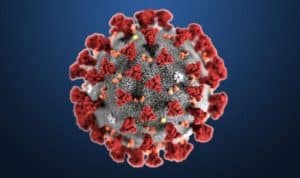
Currently the entire world is in the grip of a new disease known as COVID 19. The Disease was first described in December 2019 from Wuhan city of China. unfortunately this disease has spread to all the continents in the world. It Is well known that awareness is the key to the containment of an epidemic.
Amid of COVID-19 Global Pandemic caused by novel corona Virus all over the world, Everyone is praying and playing their role in containing the Pandemic. Once the active spread will be controlled and the infection will be contained, We all know our world will never be the same again especially in regards to the Dental fraternity and their patients.
Table of Contents
How Dentistry is a Risk Branch In Coronavirus Pandemic?
As Dental professionals we have always been at risk of exposure to various life-threatening & contagious diseases like HIV, Hepatitis B, Tuberculosis, etc which can infect or spread through saliva, oral cavity, and respiratory tract.
The New York Times on 15th March 2020 published an article “The Workers Who Face the Greatest Coronavirus Risk”, where a schematic figure described that dentists as the professionals are most susceptible to the risk of being infected by COVID-19
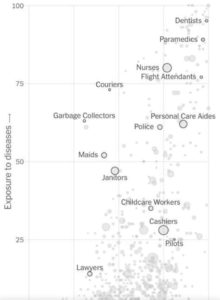
This new Coronavirus varies from all above infections by having a very high Human to Human transmission rate and relatively long Incubation period (time from getting infected to showing symptoms) which ranges from 2 to 14 days with the median duration being 5 days.
It is of concern that to date no specific guideline, treatment, or vaccine is available for nCOVID 19.
The main that should concern us as Dental Surgeon for our patients is the
–Mode of Transmission
–Virulence of Virus on Fomites.
— Patient with improper history
MODE OF TRANSMISSION IN DENTAL SETTING
The main mode of transmission of this COVID 19 infection is through Droplet Infection, which means it spreads via nasal and oral droplets released during coughing, sneezing, blowing the nose.
We as Dental Professionals are considered at very high risk due to the nature of our work that includes splatter and aerosols from the oral cavity generated by our Headpieces and Ultrasonicscalers.
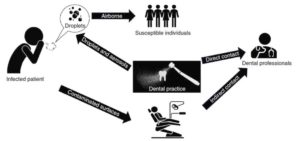
Also, another mode of spread is through Fomites.
Fomites are various objects on which if Virus can retain its infective potential for a specific period of time.
- Aerosol splatter- 3 to 8 Hours
- Copper – 4 to 5 Hours
- Stainless steel – 2-3 days
- Cardboard/plastic/Paper – up to 24 hours.
- Plastic – up to 3 days

What To Do In Case Dental Emergency During COVID 19 Period
Nonessential Dental procedures should be avoided which includes
Routine Dental Checkups and Treatments where there is no pain, swelling or bleeding
- Teeth Cleaning
- Teeth Whitening
- Most of the dental fillings ( which are asymptomatic)
- Cosmetic Dental treatments
- Denture Concerns
- Braces Treatment
- Facial Cosmetic Surgeries
Dental & Maxillofacial Emergencies Include
- Severe Acute Pain Associated with Teeth or Jaws
- Facial Infections
- Fracture of teeth or Jaw bone due to trauma
- Lacerations & Cuts on the face
- Temporomandibular Joint Dislocation
- Conditions, where the patient is suffering from some complex systemic illness & doing no treatment, may lead to worsening of the condition
- Biopsy of a suspicious lesion
Recommendations For Specific Dental Procedure:
| Dental Decipline | Special Precaution |
|---|---|
| Endodontics | Rubber Dam must be applied. Root canal treatment usually requires a number of endodontic instruments & devices, therefore minimising unnecessary hand contact with surfaces and equipment in the dental office to reduce possibility of Fomite transmission |
| Restorative & Pediatric Dentistry | Avoid using rotary instruments during cavity preparation. In selective cases consider using chemochemical caries removal or Atraumatic Restorative Techniques. Rotary instrumentation must be performed under Rubber Dam Isolation |
| Periodontics & Gums Treatment | Hand & Ultrasonic Scaling are equally effective in removing plaque and calculus. If required manual scaling and polishing is recommended |
| Prosthodontics | Salivary suction should be done with care to avoid gagging. Avoid touching other objects during Denture try in and adjustments. During Fixed partial denture or single crown preparation treatment alteration must be considered to incorporate rubber dam application eg. Supragingival margins or Split Dam Technique. Upon removal from patient's mouth, dental prosthesis, impressions and other materials should be throughly disinfected |
| Oral & Maxillofacial Surgery | Treat the patient in supine position to avoid working in breath way of patient. Consider closed reduction of jaw fractures with self drilling MMF screws. Use Scalpel over cautry. Self Drilling Screws are preferrable. Use osteotome instead of power saw for bone cutting. Avoid repeated suction & irrigation |
Precautions To Be Taken By Dentist & Oral Surgeons To Prevent nCOVID 19 Transmission
If possible avoid aerosol-related treatments (Air rotor And Scaler) till active disease gets contained.
- Strict Screening should be done and detailed written informed consent and Undertaking should be taken from ALL patients regarding COVID 19 and other diseases in General.
- Patients should be asked to scrub their hands with alcohol-based hand sanitizers provided by staff from a distance.
- Dental Chair, Hand rests, Spitoon, Tray, Buttons, Headlight switch, Door handles to be disinfected with Alcohol scrub Before and after each patient.
- Patients should be asked not to touch anything unless its unavoidable.
- A mouth rinse containing oxidative agents such as 1% Hydrogen Peroxide or 2% Povidone Iodine should be used before any procedure to reduce the salivary load of oral microbes, including potential nCOVID 19 carriages.

- All asymptomatic treatments to be deferred till the epidemic ends.
- Proper Donning and Doffing protocols if using PPE Should be followed.
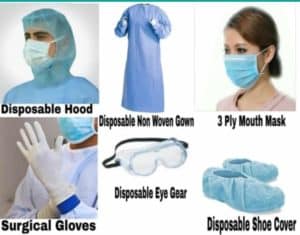
- Procedures that generate splatter & aerosols to be done with complete Disposable PPE for all operating Doctors and Assistants and appointments for such cases should preferably be scheduled at the end of the day.
- Use of Rubber Dam can significantly reduce the spatter & Aerosol from saliva and blood.
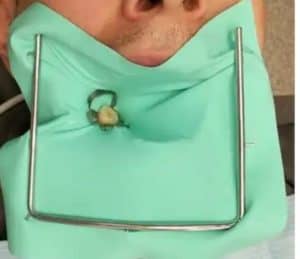
- Operatory should be fumigated with commercial fumigators or liquid Formalin and Potassium permanganate crystals.
- Appointments should be scheduled such that there should be minimal waiting time for the patients and leaving sufficient time for disinfection.
- Patients should be requested to have a mask or a nose protection worn in the reception till they are called in the operatory and maintain the spacing of 6 feet
- Routine treatments like OPD, Crown cementation, ART, can be carried out.
- Water reservoir of chair be added with 0.5%Hydrogen Peroxide
- The floor of the operatory should be mopped with the Three-bucket technique or with 1%sodium hypochlorite and detergent after each patient.
- Dispose of the PPEs and Biomedical waste judiciously.
- Patients should be encouraged to pay Fees by Digital routes
- Before and after each session meticulous floor mopping, handle disinfection, Dental chair, x rays, Trays, Spittoon, operator, and waiting area.
- Handpieces, burs, diagnostic instruments, etc, have to be autoclaved, in sealed pouches. Overlooked practices such as scrubbing the handpiece with a disinfectant and working on the next patient must be avoided under all circumstances.
- Used burs should be soaked in a disinfectant solution prior to autoclaving. Root canal files should be single-use and preferably a single visit under Rubber Dam.
- The use of Hii-vac suctions in conjunction with saliva ejectors, will help to minimize aerosol dissemination.
- Use of Air Conditioners should be restricted during Aerosol generating procedures. And should be kept ON during fumigation so that Fumigant should reach the filters. Also regular the filters should be cleaned regularly.
- Follow biomedical waste disposal protocols stringently as defined by the Municipal authorities.
- Dental Impressions should be effectively disinfected prior to dispatch to laboratories.
- Thoroughly wash the dental impression in running water after removing it from the mouth. & Gently scrub with a hairbrush and liquid detergent under running water.[For all materials including alginates, polyethers, and polysioxanes]
- Polysiloxanes impressions should be immersed in 5.25% Sodium Hypochlorite with 1:10 dilution. Alginate & Polyether impressions can be disinfected using an intermediary level disinfectant.
- Packets of work received should be disinfected first using disinfectant spray and prosthesis should be immersed in Glutaraldehyde
To ensure utmost medical professionalism, curb the spread of CoVid-19 and consequently reinstate confidence in the minds of the masses. Protocols stated above should be implemented with the reopening of dental practices.
Lastly, this will provide the patients with relief that clinics are barriers to the spread of infection, as opposed to a source.
Recommended Read:
Sources:
- https://youtu.be/BTLGGV3_XnI
- https://www.zerodonto.com/en/2020/03/covid-19-dentistry-new-coronavirus/
- https://www.ncbi.nlm.nih.gov/pubmed/15127864
- https://www.ncbi.nlm.nih.gov/pubmed/18247451
Disclaimer:
The above post is prepared by individual after going through various articles, literature, and videos available on the internet. Doctors who wish to follow all or any points mentioned are advised to please verify themselves of the facts and follow only if they are completely satisfied. The author doesn’t undertake any responsibility if some/either or all of the steps don’t match the latest updates regarding COVID 19 guidelines issued by authorities. Or any unwanted, unexpected, or untoward incidence occurring after following the above points the author will not bear any responsibility whatsoever.
Thank You.